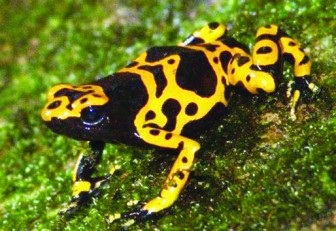The Yellow Banded Poison Dart Frog (Dendrobates leucomelas) is the largest of the Dendrobatid frogs and has been seen in the Burro Burro river of Surama and the Clarence Mountain Trail in Aranaputa. These frogs are restricted to the neo-tropics and can be found in Venezuela, northern Brazil, Colombia and Guyana. The species likes wet habitats and can be found on the forest floor among the leaf litter, near roots and moist tree trunks and rocks. It is the only known species of Poison Dart Frogs that estivate (burrow in leaf litter and sleep) during the dry season.
Dendrobates luecomelas can be distinguished by its bright yellow on black patterning. As the frog gets older it is said that the black bands break off into spots while others interpret the patterning as having black spots within the yellow bands. Either way the bright yellow colour signals a warning to potential predators indicating danger. The toxins found in the skin are poisonous to most predators. These toxins are derived from the insects that the frog eats, especially ants, in its diet.
This species is diurnal and will spend most of its time on the forest floor though it can climb. The feet are equipped with glandular pads that enable these frogs to stick to the trees when climbing. The males are especially territorial and are very aggressive in defence of their breeding territory. They are usually solitary except when breeding.
As indicated, the species is insectivorous and will feed mostly on ants, termites, spiders and small beetles. It will spend a large portion of its time foraging due to the small size of its prey.

The male of the species is the caregiver of the reproductive pair. He will find the most suitable site for the deposition of the eggs; which is usually on the underside of a leaf near water. After fertilization he will remain to protect and maintain the eggs, especially keeping them moist so that they may develop.
When the tadpoles emerge within 14 days of fertilization the male will transport them to a water source. The water source is usually found up in the canopy of water holding plants like bromeliads. The male will deposit one tadpole in each plant to prevent predation of all his offspring. The tadpoles are quite aggressive in their defence of their home, exhibiting cannibalistic behaviour if another tadpole is added to their dwelling by mistake. They develop into froglets in 60 to 70 days. The froglets are miniature versions of the adult only duller in coloration.
The species is part of the pet trade and have been bred in captivity. They are listed as least concerned by the IUCN as it is believed that the population is stable and the species quite common. They are CITES Appendix II as they are part of the pet trade and some system of control is warranted to maintain the sustainability of the trade.
Rain forests are rich in biodiversity and are home to many different plants and animals as well as indigenous communities. Humans, even those who don’t live in the rain forest, rely on it for resources such as building materials (wood and lianas), medicine and fruits. Rain forests also provide essential environmental services for life on earth; they create soil as well as prevent soil erosion, produce oxygen though photosynthesis, maintain clean water systems, and are a key defence against climate change.
The Iwokrama Rain Forest is 371,000 hectares, located in the heart of Guyana. Our mission is to develop strategies for conservation and sustainable development for local people in Guyana and the world at large. We are involved in timber, tourism and training. Come and visit us in the rain forest or at http://www.iwokrama.org.





